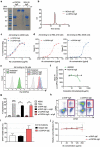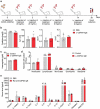In vivo safety profile of a CSPG4-directed IgE antibody in an immunocompetent rat model
- PMID: 31769737
- PMCID: PMC6927758
- DOI: 10.1080/19420862.2019.1685349
In vivo safety profile of a CSPG4-directed IgE antibody in an immunocompetent rat model
Abstract
IgE monoclonal antibodies hold great potential for cancer therapy. Preclinical in vivo systems, particularly those in which the antibody recognizes the host species target antigen and binds to cognate Fc receptors, are often the closest approximation to human exposure and represent a key challenge for evaluating the safety of antibody-based therapies. We sought to develop an immunocompetent rat system to assess the safety of a rodent anti-tumor IgE, as a surrogate for the human therapeutic candidate. We generated a rat IgE against the human tumor-associated antigen chondroitin sulfate proteoglycan 4 (CSPG4) and cross-reactive for the rat antigen. We analyzed CSPG4 distribution in normal rat and human tissues and investigated the in vivo safety of the antibody by monitoring clinical signs and molecular biomarkers after systemic administration to immunocompetent rats. Human and rat CSPG4 expression in normal tissues were comparable. Animals receiving antibody exhibited transient mild to moderate adverse events accompanied by mild elevation of serum tryptase, but not of angiotensin II or cytokines implicated in allergic reactions or cytokine storm. In the long term, repeated antibody administration was well tolerated, with no changes in animal body weight, liver and kidney functions or blood cell counts. This model provides preclinical support for the safety profiling of IgE therapeutic antibodies. Due to the comparable antigen tissue distribution in human and rat, this model may also comprise an appropriate tool for proof-of-concept safety evaluations of different treatment approaches targeting CSPG4.
Keywords: CSPG4; IgE; allergooncology; antibody; immunotherapy; rat model; species cross-reactivity.
Figures





Similar articles
-
Anti-cancer pro-inflammatory effects of an IgE antibody targeting the melanoma-associated antigen chondroitin sulfate proteoglycan 4.Nat Commun. 2023 Apr 25;14(1):2192. doi: 10.1038/s41467-023-37811-3. Nat Commun. 2023. PMID: 37185332 Free PMC article.
-
In vivo trafficking of a tumor-targeting IgE antibody: molecular imaging demonstrates rapid hepatobiliary clearance compared to IgG counterpart.Oncoimmunology. 2021 Sep 6;10(1):1966970. doi: 10.1080/2162402X.2021.1966970. eCollection 2021. Oncoimmunology. 2021. PMID: 34513315 Free PMC article.
-
An immunologically relevant rodent model demonstrates safety of therapy using a tumour-specific IgE.Allergy. 2018 Dec;73(12):2328-2341. doi: 10.1111/all.13455. Epub 2018 Oct 8. Allergy. 2018. PMID: 29654623 Free PMC article.
-
Chondroitin sulfate proteoglycan 4: An attractive target for antibody-based immunotherapy.Proc Jpn Acad Ser B Phys Biol Sci. 2024;100(5):293-308. doi: 10.2183/pjab.100.019. Proc Jpn Acad Ser B Phys Biol Sci. 2024. PMID: 38735753 Free PMC article. Review.
-
Chondroitin sulfate proteoglycan 4 as a target for chimeric antigen receptor-based T-cell immunotherapy of solid tumors.Expert Opin Ther Targets. 2015;19(10):1339-50. doi: 10.1517/14728222.2015.1068759. Epub 2015 Jul 18. Expert Opin Ther Targets. 2015. PMID: 26190756 Review.
Cited by
-
Anti-cancer pro-inflammatory effects of an IgE antibody targeting the melanoma-associated antigen chondroitin sulfate proteoglycan 4.Nat Commun. 2023 Apr 25;14(1):2192. doi: 10.1038/s41467-023-37811-3. Nat Commun. 2023. PMID: 37185332 Free PMC article.
-
A Novel Antibody-Drug Conjugate (ADC) Delivering a DNA Mono-Alkylating Payload to Chondroitin Sulfate Proteoglycan (CSPG4)-Expressing Melanoma.Cancers (Basel). 2020 Apr 22;12(4):1029. doi: 10.3390/cancers12041029. Cancers (Basel). 2020. PMID: 32331483 Free PMC article.
-
Harnessing the Anti-Tumor Mediators in Mast Cells as a New Strategy for Adoptive Cell Transfer for Cancer.Front Oncol. 2022 Mar 31;12:830199. doi: 10.3389/fonc.2022.830199. eCollection 2022. Front Oncol. 2022. PMID: 35433433 Free PMC article. Review.
-
An IgE antibody targeting HER2 identified by clonal selection restricts breast cancer growth via immune-stimulating activities.J Exp Clin Cancer Res. 2025 Feb 12;44(1):49. doi: 10.1186/s13046-025-03319-5. J Exp Clin Cancer Res. 2025. PMID: 39934835 Free PMC article.
-
IgE Antibodies against Cancer: Efficacy and Safety.Antibodies (Basel). 2020 Oct 16;9(4):55. doi: 10.3390/antib9040055. Antibodies (Basel). 2020. PMID: 33081206 Free PMC article. Review.
References
-
- Burgess M, Mapp S, Mazzieri R, Cheung C, Chambers L, Mattarollo SR, Mollee P, Gill D, Saunders NA. Increased FcgammaRIIB dominance contributes to the emergence of resistance to therapeutic antibodies in chronic lymphocytic leukaemia patients. Oncogene. 2017;36:2366–76. doi:10.1038/onc.2016.387. - DOI - PubMed
Publication types
MeSH terms
Substances
Grants and funding
LinkOut - more resources
Full Text Sources
